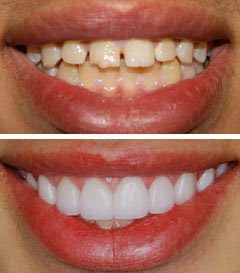If you want to improve your smile, dental veneers are a simple option.
Veneers are thin coverings that are placed over the front (visible) part of the tooth. They look like natural teeth. Veneers can be used to correct a wide range of dental issues, such as:
– Teeth that are stained and cannot be whitened by bleaching;
– Chipped or worn teeth;
– Crooked or misshapen teeth; and
– Uneven spaces or a large gap between the upper front teeth.
Veneers are made of either porcelain or composite resin material. Your dentist will help you choose the material that is best for you. Each type of veneer has its own benefits
A porcelain veneer is a thin shell that is customer-made to fit on the tooth.
Benefits of porcelain veneers:
– They are strong and long-lasting;
– They have a natural-looking surface;
– Less tooth enamel needs to be removed than with a crown or cap; and
– They do not stain easily.
A composite resin veneer is made from a tooth-colored filling material bonded to the tooth.
Benefits of composite resin veneers:
– Usually less tooth enamel needs to be removed than for crowns or porcelain veneers;
– May mean fewer visits to the dentist (sometimes these veneers take just one visit); and
– Are easy to fix if they get damaged.
Before you get veneers:
– Your teeth and gums must be healthy before you get veneers. Your dentist can treat any disease or decay before your veneers are placed.
– Veneers are not always a good choice for patients who clench or grind their teeth.
– It is possible for veneers to come loose over time.
– Regular dental visits are a must for keeping your teeth and gums healthy.
After you get veneers:
– It may take you a few days to get used to the feeling of your veneers; and
– Veneers can chip or break under pressure. Therefore avoid biting your fingernails and chewing on hard objects, such as pencils or ice.
For more information and appointments please call 5278 2666.
Get the latest news to your email inbox FREE!
REGISTERSponsored Content







